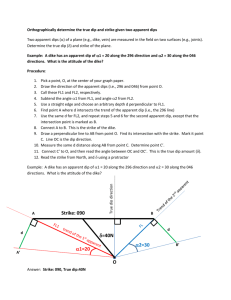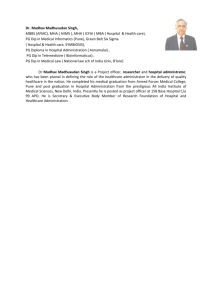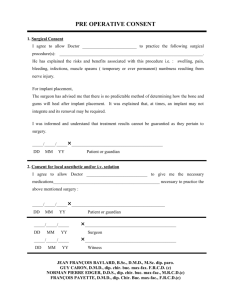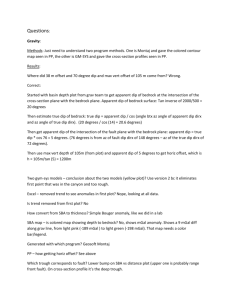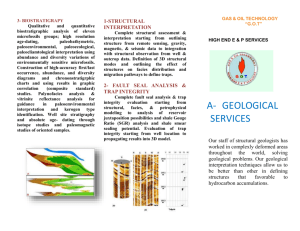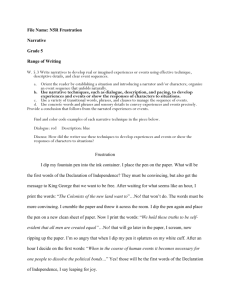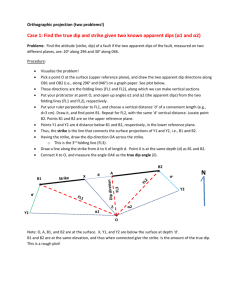Lab #1
advertisement
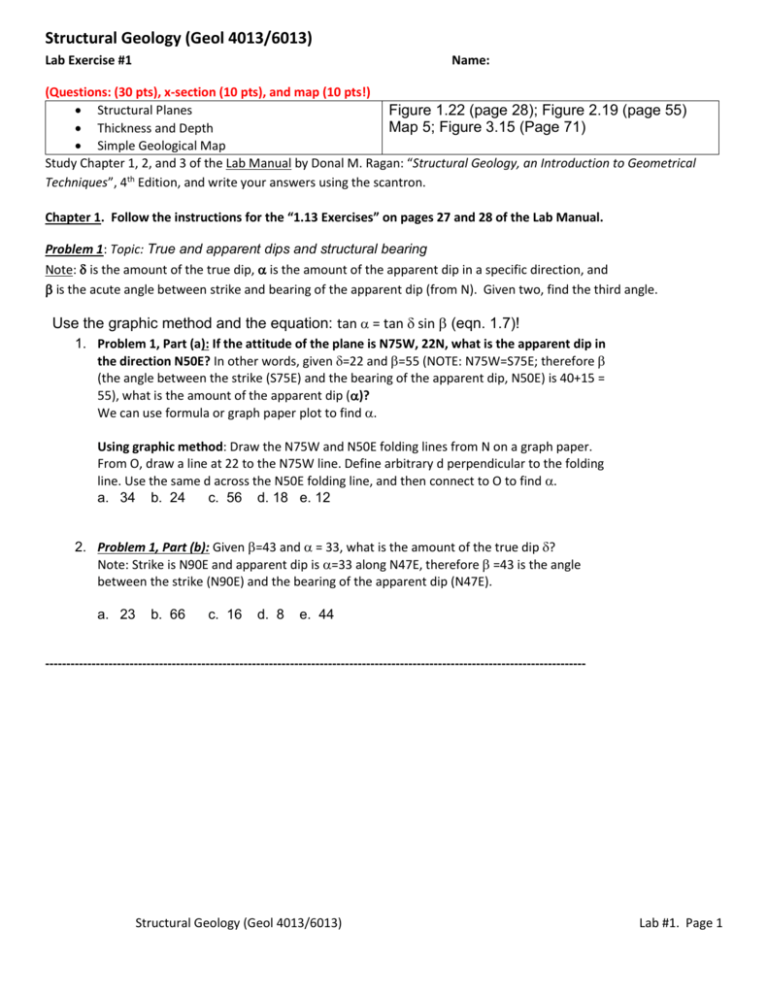
Structural Geology (Geol 4013/6013) Lab Exercise #1 Name: (Questions: (30 pts), x-section (10 pts), and map (10 pts!) Structural Planes Figure 1.22 (page 28); Figure 2.19 (page 55) Map 5; Figure 3.15 (Page 71) Thickness and Depth Simple Geological Map Study Chapter 1, 2, and 3 of the Lab Manual by Donal M. Ragan: “Structural Geology, an Introduction to Geometrical Techniques”, 4th Edition, and write your answers using the scantron. Chapter 1. Follow the instructions for the “1.13 Exercises” on pages 27 and 28 of the Lab Manual. Problem 1: Topic: True and apparent dips and structural bearing Note: is the amount of the true dip, is the amount of the apparent dip in a specific direction, and is the acute angle between strike and bearing of the apparent dip (from N). Given two, find the third angle. Use the graphic method and the equation: tan = tan sin (eqn. 1.7)! 1. Problem 1, Part (a): If the attitude of the plane is N75W, 22N, what is the apparent dip in the direction N50E? In other words, given =22 and =55 (NOTE: N75W=S75E; therefore (the angle between the strike (S75E) and the bearing of the apparent dip, N50E) is 40+15 = 55), what is the amount of the apparent dip ()? We can use formula or graph paper plot to find . Using graphic method: Draw the N75W and N50E folding lines from N on a graph paper. From O, draw a line at 22 to the N75W line. Define arbitrary d perpendicular to the folding line. Use the same d across the N50E folding line, and then connect to O to find . a. 34 b. 24 c. 56 d. 18 e. 12 2. Problem 1, Part (b): Given =43 and = 33, what is the amount of the true dip ? Note: Strike is N90E and apparent dip is =33 along N47E, therefore =43 is the angle between the strike (N90E) and the bearing of the apparent dip (N47E). a. 23 b. 66 c. 16 d. 8 e. 44 -------------------------------------------------------------------------------------------------------------------------------- Structural Geology (Geol 4013/6013) Lab #1. Page 1 Problem 4: Topic: calculating apparent dip for the construction of structural cross section. You need to use orthographic projection (see Figure 1.11)! Given the following attitudes, draw a vertical cross section along XX’ on Figure 1.22 (Page 28). Notice the lack of topography (i.e., there is no need to draw the topographic profile for the section)! Fault: 000, 60W Dike: 315, 70NE Beds: 024, 30 NW Line of cross section (XX’): 090 Note: You need to convert the true dips (), shown along the tick of the attitude symbols (also given above), to apparent dips (). You must use the apparent dips () for your cross section (not the true dips!) Only use the true dips on cross sections if the line of section is along the dip). To do this, you can either use the nomogram, stereonet, or formula! Here, we use formula (tan = tan sin ). 3. What is the apparent dip α for the fault along the line of section (i.e., along 090)? tan = tan sin = 35 W b. 76W c. 24W d. 60W e. 76 W 4. What is the apparent dip α for the dike along the line of section (i.e., along 090)? a. 42E b. 62E c. 76E d. 76W e. 37 E 5. What is the apparent dip for the bedding in the rock units along the line of section (along 090)? a. 12E b. 18W c. 18E d. 48W e. 28 W /10 pts Attach your cross section for 10 points! Structural Geology (Geol 4013/6013) Lab #1. Page 2 Chapter 2. Read the instructions for the following selected problems of the “2.11 Exercises” on page 54 of the Lab Manual. Attach all your work! Problem 1a, Page 54 (Figure 2.18a) Topic: Strike normal traverse. Given = 36 and w=42 m, do the following: 6. What is the graphically-determined thickness (t) of the layer if the top and bottom of the layer are at points O and A? See Figs. 2.4a and 2.4b, page 32 for guide. Note 1: Use length of w = 42 m in Figure 2.18a as scale! Note 2: dip = 36 a. 16 m b. 24 m c. 35.2 m d. 43 m e. 9 m 7. In Figure 2.18a, what is the thickness (t), determined using equation 2.1 (t = w sin )? From graph (Fig. 2.4b, page 32): sin = t/w. t=(sin) w = a. 16.32 m b. 24.70 m c. 35.2 m d. 43.8 m e. 9.5 m Problem 1b, Page 54. Do the following: (see Section 2.8, Page 43) 8. What is the graphically-determined depth (d) to the lower boundary at point A on Fig. 2.18a (w = 42 m)? a. 20 m b. 64 m c. 30 m d. 57 m e. 14 m 9. What is the approximate depth (d), determined using eqn. 2.16a on Fig. 2.18 a (d = w tan )? d = w tan = a. 20.6 m b. 64.5 m c. 30.5 m d. 57.6 m e. 14.2 m Chapter 2: Page 54. Fig. 2.18b. Problem 2a. Topic: oblique traverse. Determine the following: (see Fig. 2.4, page 32, & eqn 2.2) 10. What is the graphically-determined thickness (t) of the layer? NOTE: = 60, =23, l = 54 m Note: in this case, just use l instead of w, and construct the triangle l 36 a. 18 m b. 29 m c. 65 m d. 77 m e. 83 m t \ 11. What is the thickness (t), determined using equation 2.2 (t = l sin sin)? t = l sin sin = 54(sin60)(sin 23) = 18.27m a. 31 m b. 12 m c. 46 m d. 57 m e. 18 m Problem 2b, page 54. Determine the following: 12. What is the graphically-determined depth (d) to the lower boundary at point B (note: l=54 m)? a. 62 m b. 20 m c. 37 m d. 41 m e. 47 m 13. What is the depth (d), determined using equation 2.18 (d = l sin tan)? = 60, =23, l = 54 m. a. 26.2 m b. 6 m c. 20 m d. 45.6 m e. 72 m Structural Geology (Geol 4013/6013) Lab #1. Page 3 Chapter 2, Problem3 (Page 54): Topic: Dip and slope relationships and thickness determination Determine the following (note: is true dip, and is the slope angle): 14. What is the thickness for Unit 1? Use case 3 on page 34. (+ < 90), where dip and slope in opposite directions, and =50 and =10. (t= w sin (+)). a. 8.2 m b. 5 m c. 7.1 m d. 4.6 m e. 10.3 m 15. What is the thickness for Unit 2? Use case 3 on page 34. (+ < 90), where dip and slope are in opposite directions, and =50 and =15 (t= w sin (+)). a. 28.2 m b. 15.5 m c. 17.9 m d. 2.4 m e. 7.25 m 16. What is the thickness of Unit 3? Use case 7 on page 34. ( + < 90), where dip and slope are in the same direction, and =50 and =-13 (t= w sin (-)). a. 7.84 m b. 3.5 m c. 19.1 m d. 2.6 m e. 12.3 m 17. What is the thickness of Unit 4? Use case 3 on page 34. (+ <90), where dip and slope are in opposite directions, and =50 and =18 (t= w sin (+)). a. 12.2 m b. 5.5 m c. 7.9 m d. 16.41 m e. 8.3 m 18. What is the thickness of Unit 5? Slope is horizontal and =50 and =0 (t= w sin ). a. 15.2 m b. 11.8 m c. 11.1 m d. 5.13 m e. 14.3 m 19. What is the total thickness of the whole sequence (units 1 through 5 in Figure 2.19)? a. 17.36 m b. 33.82 m oc. 43.73 m d. 65.6 m e. 86.12 m _________________________________________________________________________________ Structural Geology (Geol 4013/6013) Lab #1. Page 4 Problem 4 (NOT from the book!): Topic: Simple geological map with topographic contours. The attached geological Map 5 (Scale: 1:40,000, i.e., 1cm = 400 m) shows a sequence of deformed rocks. The dashed-dotted lines are topographic contours. The straight lines are structural contours. Notice that the rock units repeat on the map! The map already has all the structural contours (straight, parallel lines) drawn. Color the marker Sandstone unit with a red highlighting pen Label the elevation (in m) for the structural contours for both contacts of each of the four exposures of the Sandstone marker bed 20. How much is the vertical thickness of the Sandstone Unit? a. 50 m b. 200 m c. 100 m d. 300 m e. 25 m 21. What is the apparent dip of the third exposure of the Sandstone unit from the left (West)? a. 68W b. 10W c. 22E d. 56W e.25W 22. What kind of structure do the repeated rock units (Sandstone) represent? a. anticline b. antiform c. antiforms and synforms d. horizontal units e. none of these 23. Why are the structural contours parallel? Because: a. The folds are horizontal, i.e., their fold axis is non-plunging b. The fold axial planes are horizontal c. The limbs of the folds are vertical d. All the folds are synforms e. None of the above Determine all the true dips; put them on the map with proper strike/dip symbols. Use the structural contours for this purpose. /10 pts Draw the topographic profile along the northern edge of the geological map. Draw a precise vertical cross section along the northern edge of the map, using the apparent dips (NOT the true dips). NOTE: Scale: 1:40,000. (There should be No vertical exaggeration!) NOTE: Calculate the apparent dips from the true dips using equation or the graphic method! ATTACH YOUR GEOLOGICAL CROSS SECTION FOR CREDIT! ________________________________________________________________________ Structural Geology (Geol 4013/6013) Lab #1. Page 5 Chapter 3: Do Problems 1 & 2 of the “3.10 Exercises” on Page 71. Read problem 1. The strike (that is, the structural contour) and dip for Plane B is shown at the 710 m elevation. We want to intersect the two planes (A and B) at the 710 m elevation. So, we need the structural contour for Plane A at 710m. Determine the line of intersection of the two planes. Hint: First find out the horizontal spacing for the structural contours for 10 m contour intervals (i.e., given the true dip amount (), and the 10 m vertical distance (h), determine the horizontal distance (l) between these contours using trigonometry, where l = h/ tan. Do this separately for planes A and B, and then draw the structural contours on these two planes (i.e., draw them parallel to the strike line shown on the attitude symbol). Find the intersection point of specific structural contours (e.g., 710 m) on planes A and B. Repeat for other elevations. Connect these intersection points for several elevations to get the intersection line! Read the angle that the line of intersection makes with the strike of plane A (this is the pitch of the line). Read the trend of this line from the geographic reference, and determine its plunge from the horizontal using trigonometry from the two elevations at its two ends. Determine the following: 24. What is the approximate depth to the line of intersection of Plane A and Plane B (i.e., the vein) at Boulder Creek? a. 82 m b. 17 m c. 24 m d. 1 m e. 30 m 25. What is the attitude (trend, plunge) of the line of intersection? a. 180, 10 b. 060, 48 c. 120, 76 d. 212, 33 e. 270, 40 26. What is the pitch of the intersection line in plane B? a. 21NW b. 55SE c. 43SW d. 15NE e. 12N _____________________________________________________________-------------------Chapter 3, Problem 2 (Figure 3.15). Read Problem 2 on Page 71. Show the location where a drill hole encounters the vein system along the line of intersection of the two planes (i.e., where the Boulder Creek drainage intersects the line of intersection). Mark it as ‘p’. Hint: Find the depth at which the two structural contours intersect. Then find the surface elevation above this point. Then subtract these two values! 27. At what depth do the two structural contours intersect? a. 158 m b. 239m c. 120 m d. 340 m e. 683 m 28. What is the surface elevation above the intersection in the drainage? a. 420 m b. 590 m c. 230 m d. 707 m e. 850 m 29. At what depth the drill hole encounters the line of intersection? a. 10 m b. 66m c. 24 m d. 80 m e. 700 m Attachments: Figure 1.22 (page 28) Figure 2.19 (page 55) Map 5 Figure 3.15 (Page 71) Structural Geology (Geol 4013/6013) Lab #1. Page 6
